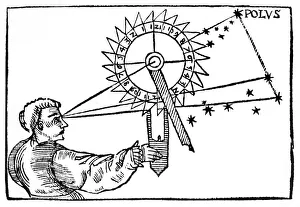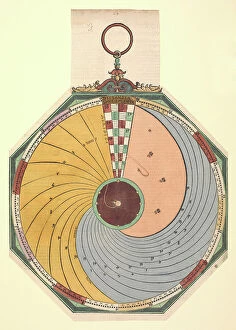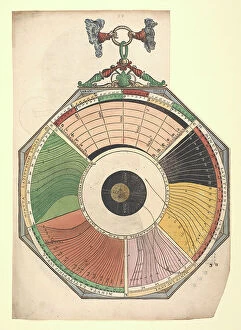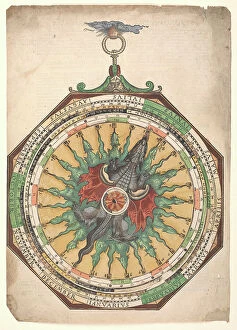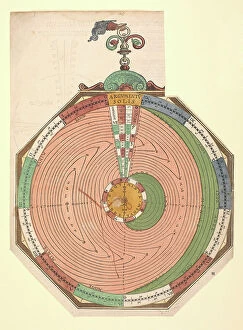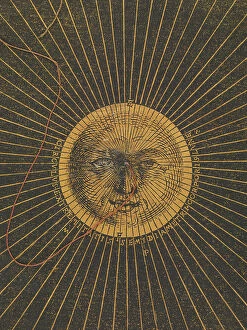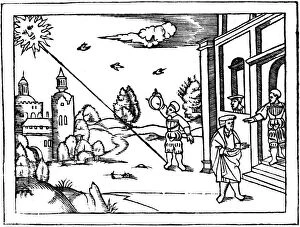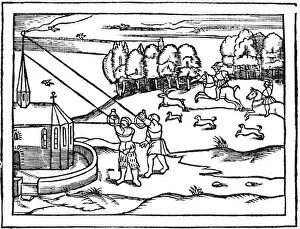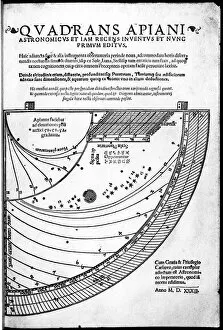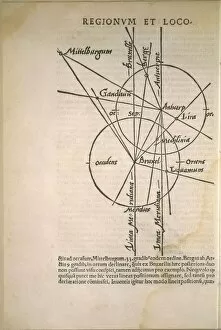Peter Apian Collection
Peter Apian (1495-1552) was a German mathematician, astronomer, and cartographer
Choose a picture from our Peter Apian Collection for your Wall Art and Photo Gifts
24 items
All Professionally Made to Order for Quick Shipping
-
Peter Apian Collection
Peter Apian (1495-1552) was a German mathematician, astronomer, and cartographer. He is best known for his work in mathematics and astronomy, particularly for his book Astronomicum Caesareum which was published in 1540. This book contained the first printed star charts as well as tables of planetary positions. Apian also wrote several other books on mathematics and astronomy including Instrumentum Primi Mobilis (1524), Cosmographia (1524), Arithmeticae Practicae Libri Duo (1527) and De Ratione Mensurandi (1530). He also invented several instruments such as the astrolabe, quadrant, sundial and cross-staff. His work greatly advanced the field of mathematics and astronomy during the Renaissance period.
+
Our beautiful pictures are available as Framed Prints, Photos, Wall Art and Photo Gifts
The Peter Apian collection from Media Storehouse is a stunning array of wall art, framed prints, photo prints, canvas prints, jigsaw puzzles and greeting cards. Our collection features the works of Peter Apian (1495-1552), a German mathematician and cartographer who made significant contributions to the fields of astronomy and geography during the Renaissance period. His maps were highly accurate for their time and he was also known for his work on sundials. Our collection includes beautiful reproductions of some of Apian's most famous works such as his world map from 1520 which shows the Americas for the first time in history. Other notable pieces include his celestial chart depicting constellations and his treatise on arithmetic which was widely used in schools throughout Europe. These high-quality reproductions are perfect for anyone interested in history, science or art. They make great gifts or can be used to decorate any home or office space with a touch of sophistication and elegance.
+
What are Peter Apian (Artists Arts) art prints?
Peter Apian art prints are a collection of high-quality reproductions of the works of Peter Apian, a renowned German mathematician and cartographer who lived in the 16th century. These prints showcase his intricate and detailed maps, charts, and diagrams that were used for scientific purposes during his time. The collection includes various pieces such as "Cosmographia," which is considered one of the most important works in the history of cartography. It also features other notable pieces like "Astronomicum Caesareum" and "Instrument Buch." These art prints are perfect for those interested in history, science, or simply appreciate beautiful artwork. They can be displayed at home or office spaces to add an intellectual touch to any room. Peter Apian art prints offer a glimpse into the mind of one of history's greatest thinkers while providing stunning visuals that are sure to impress anyone who sees them.
+
What Peter Apian (Artists Arts) art prints can I buy from Media Storehouse?
We offer a wide range of Peter Apian art prints for purchase. Some of the popular options include his astronomical drawings, which depict celestial bodies and their movements in great detail. These prints are perfect for anyone interested in astronomy or science, as they provide an accurate representation of the night sky. In addition to his astronomical works, Media Storehouse also offers prints of Apian's maps and cartography. These pieces showcase his skill at creating detailed and accurate maps that were used by explorers and navigators during the Renaissance period. Finally, Media Storehouse also has a selection of Apian's botanical illustrations available for purchase. These prints feature intricate depictions of plants and flowers from around the world, making them ideal for nature lovers or those looking to add some natural beauty to their home decor. There is a diverse range of Peter Apian art prints available from Media Storehouse that cater to different interests and tastes.
+
How do I buy Peter Apian (Artists Arts) art prints?
To purchase Peter Apian's art prints from Media Storehouse, you can browse our extensive collection of his works on their online platform. Once you have found the print that speaks to you, simply add it to your cart and proceed to checkout. You will be prompted to enter your shipping and billing information before finalizing the transaction. We offer a variety of payment options including credit card and PayPal for added convenience. Their secure checkout process ensures that all personal information is kept safe. Peter Apian's art prints are available in various sizes and formats such as canvas or framed prints, allowing you to choose the perfect option for your space. Whether you're looking for a bold statement piece or something more subtle, we have a wide selection of Peter Apian's artwork that is sure to suit any taste or style.
+
How much do Peter Apian (Artists Arts) art prints cost?
We offer a wide range of Peter Apian art prints for purchase. The cost of these prints varies depending on the size and type of print that you choose. We have a variety of options available including canvas prints, framed prints, and poster prints. Each option has its own unique price point. Our Peter Apian art prints are high-quality reproductions of his original works, which feature intricate details and beautiful colors. They make great additions to any home or office space and are perfect for those who appreciate fine art. We take pride in offering affordable prices for our customers while maintaining the highest quality standards possible. Our goal is to provide our customers with access to some of the most beautiful artwork from around the world at reasonable prices. If you're interested in purchasing a Peter Apian art print from Media Storehouse, please browse our selection online or contact us directly for more information about pricing and availability.
+
How will my Peter Apian (Artists Arts) art prints be delivered to me?
We take great care in ensuring that your Peter Apian art prints are delivered to you safely and securely. We use high-quality packaging materials to protect your artwork during transit, including sturdy cardboard tubes for rolled prints and flat boxes for mounted or framed prints. Once your order is processed, our team will carefully package your artwork and arrange for it to be shipped via a reliable courier service. You will receive a tracking number so you can monitor the progress of your delivery online. We understand how important it is to receive your artwork in pristine condition, which is why we take every precaution necessary to ensure that it arrives at its destination intact. Whether you're purchasing a single print or multiple pieces of art, rest assured that we'll handle everything with the utmost care and attention to detail.


